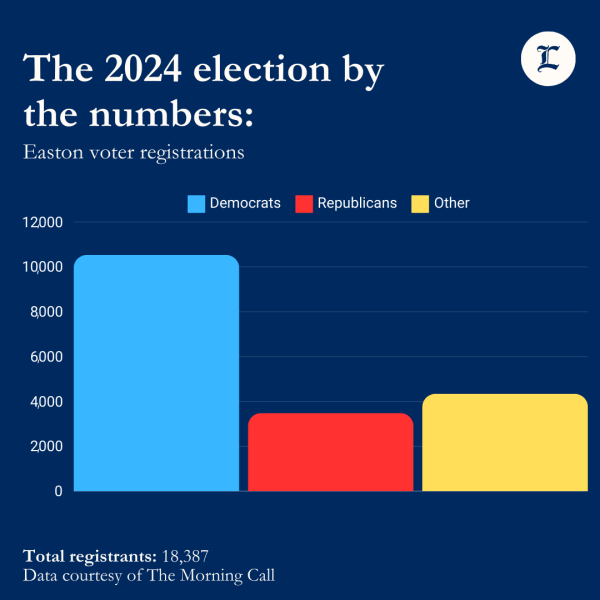Election Day has arrived, and voter registration data has been finalized. Before the 2024 presidential election is decided, let’s take a closer look at the final numbers.
In the last month, Pennsylvania Republicans have closed in on the Democratic Party’s slight lead in voter registration, emphasizing the Keystone State as one of this election’s most pivotal, but unpredictable battlegrounds.
According to data uploaded by the commonwealth, the 2024 election season has seen 9,160,849 people registered to vote across the entire state. Out of this total, 3,991,381 registered as Democrats, just edging out the Republican Party, which saw 3,709,844 registered voters — a difference of only 280,000 individuals, demonstrating a narrowing margin between the two parties.
In 2020, Pennsylvania’s final voter registration numbers showed a statewide Democratic margin of 700,853 individuals, with President Joe Biden narrowly winning by 1.17% of the vote. In 2016, Democratic registration led Republican by 916,274 voters, though the year saw former President Donald Trump take office, having won by a margin of just 0.72% — the narrowest margin in a presidential election since 1840.
NBC News speculated that the change in voter registration could be attributed to Pennsylvanians previously registered as Democrats switching their registration.
According to data analyzed by NBC, 160,000 Pennsylvanians registered as Democrats in 2021 are now registered as Republicans. Another 83,000 then-Democrats are now registered as unaffiliated. Comparatively, NBC found that only 58,000 Republicans altered their registration to the Democratic Party during the same time, with close to 50,000 shifting to unaffiliation.
To John Kincaid, a government and law professor and the director of Lafayette’s Meyner Center for the Study of State and Local Government, it is “concerning to the Democrats that the registration has narrowed as much as it has before this election.”
“I think it’s being driven by the economy and the inflation issue,” said Kincaid of the rising number of Republican voter registrations. “That’s driving a lot of voters in the Trump direction.”
As of Monday, Northampton County has 234,555 registered voters. Of them, 99,286 registered as Democrats, 87,568 as Republicans and 37,153 registered under no affiliated party. The remaining 10,538 voters were registered as “other,” a label comprised of groups like the Green Party and Libertarian Party.

“A few 1000 voters in this county can make the difference in which way the county goes,” Kincaid said.
Echoing the commonwealth as a whole, Northampton County has also seen the margin between Democratic and Republican registrants diminishing. Just four years ago, Democrats in the county led by a margin of over 20,000 registered voters. Today, that margin is less than 12,000.
“The county, in many respects, is really kind of a microcosm of the state, so there’s not a huge difference between the two,” Kincaid said.
The City of Easton, however, has maintained a large Democratic lead through the finalization of registration numbers.
According to The Morning Call, 10,675 (57.5%) Easton residents registered as Democrats, while 3,438 (18.9%) registered as Republicans and 4,340 (23.6%) registered as “other.”
In Easton’s 3rd Ward 3rd District, a region of the city that includes Lafayette College’s campus, a total of 2,582 people were registered.

Over 60% of these registrants were registered as Democrats while 24% were registered as “other.” The remaining 344 people were registered as Republicans.
Easton has seen meager voter turnout rates in previous elections, with just 53.6% and 58.4% of eligible voters participating in the 2016 and 2020 elections, respectively.
Kincaid said he believes voter turnout will increase this election given the polarity between political parties. However, despite an analysis of registration numbers, he did not venture to predict the outcome of the election.
“It’s really impossible to predict what’s going to happen, and we’re probably not going to know the outcome of the election tomorrow night,” Kincaid said.
Andreas Pelekis ’26 contributed reporting.
























































































































P • Nov 5, 2024 at 1:57 pm
Thank you for the article. I thought I should point out that it is very possible that the changes in the party affiliation could be related to Pennsylvania’s closed primary system.
That is, many of those 160,000 who changed registration from Democrat to Republican could have done so to vote for Nikki Haley (/against Trump) in the Republican primary earlier this year. I saw many voters (in other states) on the news say they were Democrats and changed to Republican so they could vote for Nikki Haley as a way of defying Trump, so it’s definitely a known strategy.
Yes, Nikki had already dropped out about a month prior to the PA primary, however she still received ~157k votes (according to Wikipedia).
Obviously this wouldn’t account for all of those who switched, but it’s a totally different picture when you consider the above.